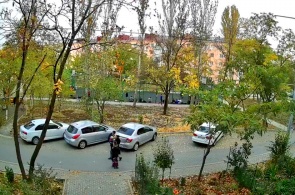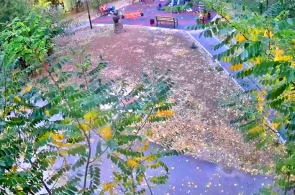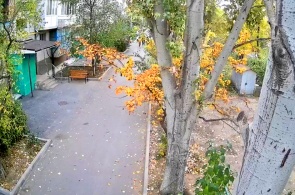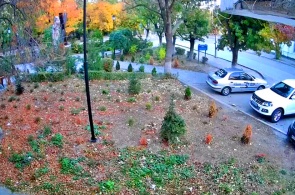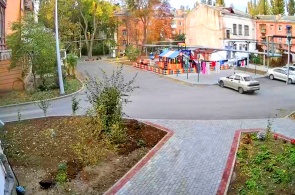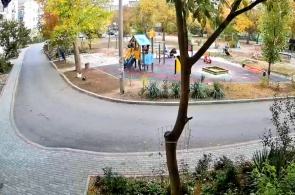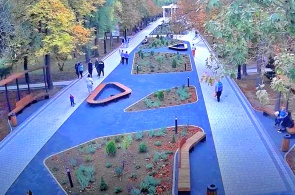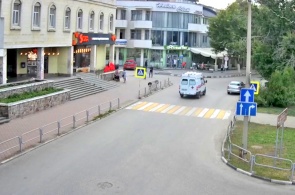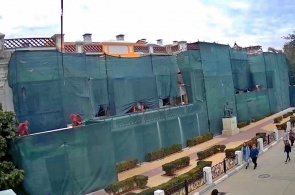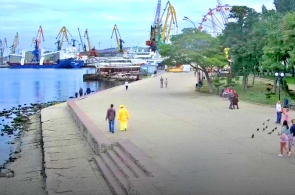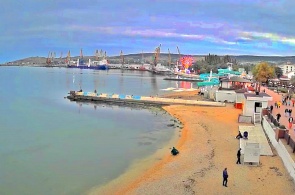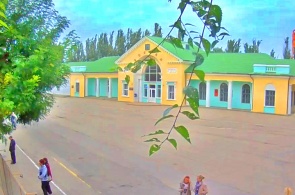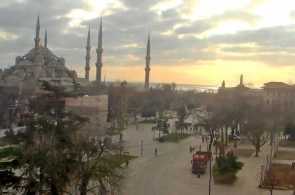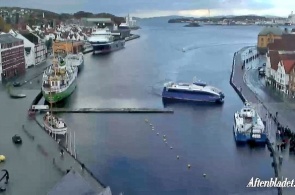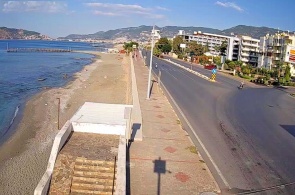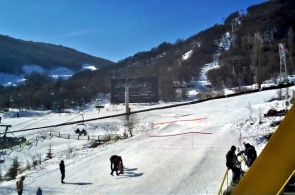Feodosia has long attracted representatives of the creative intelligentsia. This city is the birthplace of the outstanding seascape painter Ivan Konstantinovich Aivazovsky, who became famous for his realistic images of the sea in his youth. The artist's museum-gallery in Feodosia is the "home" for the world's largest collection of his canvases. Here are collected personal belongings, photographs and documents telling about the life and creative path of the master.
Also, for a certain period of his life, the outstanding Russian writer Alexander Grin, who is the author of the famous novels "Scarlet Sails" and "Running on the Waves", lived in Feodosia. In the house where the master of words lived, today there is also a museum, decorated in the style of a ship.
The Tsvetaev sisters, who came to the city after the death of their father at the beginning of the 20th century, also lived in Feodosia. They regularly participated in creative evenings, recited poetry at poetry meetings, and conducted various social activities.
Marina Tsvetaeva in her memoirs described the period of her life in Feodosia with great tenderness and nostalgia.
Today the Tsvetaevs Museum is equipped in Feodosia. His expositions are housed in Anastasia's house. The collections include personal items, authentic furnishings from the period. The museum staff managed to recreate the interiors and convey the atmosphere of the early 20th century. The walls of the house-museum are decorated with various photographs of the sisters, as well as paintings.
The museum is open all year round. But the recommended month to visit it is August. At this time, the annual poetry and music festival takes place here, which lasts for five days. Admission to the event is free.
Two more objects belong to the same period, which, although they are not museums, are magnificent monuments of architecture. The first is the Milos cottage, built in a neoclassical style with elements of antique architecture. It belonged to the family of Ibrahim Crimea, a successful merchant belonging to the Karaite dynasty.
The building has white and yellow facades, magnificent columns-caryatids, as well as a rotunda, which houses the statue of Venus de Milo, which gave the name to this object. Today, a sanatorium is located within the walls of the Milos dacha.
The second dacha, built at the beginning of the 20th century, bears the name of the “tobacco king of Crimea” Joseph Stamboli. The object is made in an eclectic style, including elements of oriental architecture and modernity. The central object of the building is a high minaret. The building has stunning decor, and the surrounding area is lavishly decorated with flower beds and fountains.
During the Soviet era, a sanatorium was also located in Stamboli's dacha. There is a hotel here today.
Also, for a certain period of his life, the outstanding Russian writer Alexander Grin, who is the author of the famous novels "Scarlet Sails" and "Running on the Waves", lived in Feodosia. In the house where the master of words lived, today there is also a museum, decorated in the style of a ship.
The Tsvetaev sisters, who came to the city after the death of their father at the beginning of the 20th century, also lived in Feodosia. They regularly participated in creative evenings, recited poetry at poetry meetings, and conducted various social activities.
Marina Tsvetaeva in her memoirs described the period of her life in Feodosia with great tenderness and nostalgia.
Today the Tsvetaevs Museum is equipped in Feodosia. His expositions are housed in Anastasia's house. The collections include personal items, authentic furnishings from the period. The museum staff managed to recreate the interiors and convey the atmosphere of the early 20th century. The walls of the house-museum are decorated with various photographs of the sisters, as well as paintings.
The museum is open all year round. But the recommended month to visit it is August. At this time, the annual poetry and music festival takes place here, which lasts for five days. Admission to the event is free.
Two more objects belong to the same period, which, although they are not museums, are magnificent monuments of architecture. The first is the Milos cottage, built in a neoclassical style with elements of antique architecture. It belonged to the family of Ibrahim Crimea, a successful merchant belonging to the Karaite dynasty.
The building has white and yellow facades, magnificent columns-caryatids, as well as a rotunda, which houses the statue of Venus de Milo, which gave the name to this object. Today, a sanatorium is located within the walls of the Milos dacha.
The second dacha, built at the beginning of the 20th century, bears the name of the “tobacco king of Crimea” Joseph Stamboli. The object is made in an eclectic style, including elements of oriental architecture and modernity. The central object of the building is a high minaret. The building has stunning decor, and the surrounding area is lavishly decorated with flower beds and fountains.
During the Soviet era, a sanatorium was also located in Stamboli's dacha. There is a hotel here today.
More details
Camera with a view of the Chernobyl Square in Feodosia (Crimea). The lens captures a spacious, picturesque area, which has become one of 5 public locations, landscaped within the framework of the regional and all-Russian projects "Formation of a comfortable urban environment" and "Housing and urban environment". The broadcast is broadcast in real time.
Feodosiya, Crimea
11.11.21
Webcam with a view of the adjoining territory at 12 Starshinova Street in Feodosia (Crimea). The lens captures parking for cars and a cozy front garden. Behind it there is a sports ground, which appeared here relatively recently, as part of the state improvement program. The broadcast is carried out in real time.
Feodosiya, Crimea
10.11.21
Live webcam is installed at Simferopol highway, 1 in Feodosia (Crimea). The lens of the device captures a fragment of a modern playground and the adjoining territory, which was recently landscaped within the framework of the state program. The broadcast is carried out in real time.
Feodosiya, Crimea
09.11.21
The webcam is installed in the courtyard of the house number 28A on the Crimean street in Feodosia (Crimea). The lens covers a landscaped area near the house, which was reconstructed within the framework of the state program. Here is the MFC, tax office, post office. The broadcast is carried out in real time
Feodosiya, Crimea
07.11.21
Camera overlooking the Monument to St. Andrew the First-Called in Feodosia. The monument is located next to Karl Marx Street. The lens captures a recently landscaped square and a monument representing a cult sculptural image. Nearby there is a parking lot, an extensive public garden. The broadcast is broadcast in real time.
Feodosiya, Crimea
06.11.21
The camera is located in the courtyard of the house number 42 on the street. Gorky in Feodosia (Crimea). The lens captures a landscaped house area with a modern playground, cobbled sidewalks and flower beds. The landscaping of the courtyard took place quite recently, and now you can watch the renovated recreational area in real time.
Feodosiya, Crimea
06.11.21
The device is installed at house No. 5 on Zheleznodorozhnaya Street in Feodosia (Crimea). The lens captures a cozy adjoining territory with a playground and flower beds, which was recently landscaped within the framework of the state program. Today, in real time, you can observe the well-groomed courtyard and keep abreast of what is happening in the distant sunny town.
Feodosiya, Crimea
05.11.21
Camera overlooking the monument to Sokovnin in Feodosia (Republic of Crimea). The lens covers the wide roadway and the adjacent square, where the monument is installed. The bust was installed in 2002, not far from the Good Genius fountain. N.M. Sokovnin is a vice admiral who became famous in the Crimean War during the defense of Sevastopol.
Feodosiya, Crimea
07.10.21
Live webcam is positioned in the Feodosia park "Yubileiny" (Republic of Crimea). The lens covers a spacious, well-maintained alley with flower beds and bushes. In the background you can see the Good Genius fountain, which was created in honor of I.K. Aivazovsky, who bought a land plot for the city, on which a fresh water source was located.
Feodosiya, Crimea
07.10.21
The camera is positioned in the Crimean city of Feodosia. The lens of the device captures a large store "Novy Svet" and the adjacent territory. The object is located on the street. Nazukin 9/1. There is a shop, cafe and hotel here. The view opens from the side of the road. The broadcast is broadcast in real time.
Feodosiya, Crimea
06.10.21
Webcam overlooking the monument to I.K. Aivazovsky, near the gallery founded by the artist (Feodosia, Crimea). The lens covers the spacious street, the museum building and the monument itself. The gallery was opened in 1880. It includes 417 paintings by Aivazovsky, representing the most extensive collection of paintings by the marine painter in the world. The broadcast can be watched in real time.
Feodosiya, Crimea
06.10.21
The camera is positioned in the resort city of Feodosia (Republic of Crimea). The paratroopers' embankment gets into the lens of the device. In the background you can see the cargo cranes of the Feodosia port and the Ferris wheel. On the left, the overview covers the Black Sea. The broadcast is carried out in real time.
Feodosiya, Crimea
06.10.21
The webcam is installed in the city of Feodosia (Republic of Crimea) with a view of the city port and the lighthouse. The lens covers the strip of the beach and the embankment adjacent to it. The port's cargo cranes and a lighthouse are visible in the background. There is also a Ferris wheel with amazing views of the sea and urban surroundings. The broadcast is conducted online.
Feodosiya, Crimea
05.10.21
Camera with a view of the station square in Feodosia (Crimea). The lens captures a spacious platform, in the background of which you can see the one-story building of the railway station. Nearby there is a park and a city embankment, numerous cafes and museums. The broadcast is broadcast in real time.
Feodosiya, Crimea
05.10.21
Camera overlooking General Gorbachev Street in Feodosia (Republic of Crimea). The overview covers a large pedestrian zone, an abundance of shops and cafes. Here you can order a pleasure van or take a walk. The angle opens from the side of the 2nd crossing. The broadcast is carried out in real time.
Feodosiya, Crimea
05.10.21
popular camerasshow all
Sultanahmet or Blue mosque is a work of art of Turkish-Islamic architecture. Its construction began in 1609, the construction work took seven years to a 19-year-old Sultan. The name of the mosque was, due to its interesting and unique finish.
Istanbul, Turkey
08.02.14
Stavanger, a town in the commune of Norway, located in the South-Western part of the country, on the Peninsula, rich in minerals. Tanager combines the influence of foreign organisations such as NATO and oil companies. The camera will shoot the harbour and the promenade of the city.
Stavanger, Norway
03.11.13
A webcam broadcasts the district of Tosmur - quiet location in the Eastern part of Alanya, located only five kilometres from the city centre. Its rural way of life and the beauty of untouched nature attract tourists.
Alanya, Turkey
10.11.18
Shark Island or in English of Shark island, located in the harbour city of Sydney, the suburb of Point Piper. The locals, the natives named the island Boambilly, which translated means Shark island. After all, this name is not casual, because it's mean and looks like a shark fin.
Sydney, Australia
31.10.13
The webcam is installed on site Alva. Tsaghkadzor ski resort town in Armenia. Tsaghkadzor is a beautiful mountainous area among deciduous forests, with a pleasant winter climate, and clean fresh air. The highest point is 1800 meters. The truss type is a classic, divided into three.
Tsakhkadzor, Armenia
18.01.14


